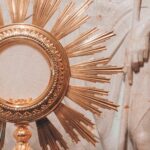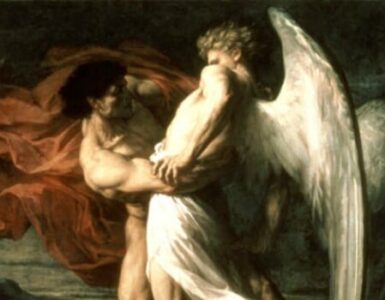Central to our faith is the Eucharistic celebration and our reception of Holy Communion. This act of unity is intended to convey a belief in, as St. Paul states, “a common faith, hope and Lord.” Unfortunately, there are divergent views among Catholics as to what takes place at the Eucharistic celebration. Specifically, those divergent views center on the very nature and reality of what Holy Communion is. Recent national surveys have indicated that only thirty percent of American Catholics believe in the Real Presence of Jesus in the Blessed Sacrament. Equally, if not more, troubling is the fact that these surveys further convey that this percentage increases to a mere sixty-two percent for those that attend mass regularly (defined as attending Mass at least once per month).
In part, this lack of belief in the True Presence is the result of poor catechesis within the Church for several decades. To address this problem the bishops of the American Church have inaugurated a two-year Eucharistic Revival that began on July 1, 2022, and will conclude on June 30, 2024. In the first year, activities in each diocese will occur at the diocesan level. With the commencement of the second year, beginning on July 1, 2023, the focus will shift to the parish level.
To that end and in preparation for a Eucharistic Revival in parishes across the country, I would like to present to you nine proofs or strong arguments that, taken individually, vigorously support the belief in the True Presence of Jesus in the Blessed Sacrament. But, in my opinion, when taken as a whole, the nine proofs present irrefutable evidence of this. Not symbol but rather His very self, made Truly Present in His Body, Blood, Soul, and Divinity.
So let me begin with the first proof. It is Jesus’ own words that testify to His True Presence in the Blessed Sacrament in the “Bread of Life discourse” found in Chapter 6 of John’s Gospel. “Amen, amen I say to you unless you eat the flesh of the Son of Man and drink his blood you do not have life within you. Whoever eats my flesh and drinks my blood has eternal life, and I will raise him up on the last day. For my flesh is true food and my blood is true drink. Whoever eats my flesh and drinks my blood remains in me and I in him” (Jn 6:53-56). Four times in these four verses Jesus emphatically states that we must eat his flesh and drink his blood to attain eternal life. There is no symbolism contained in these words.
In fact, it becomes even more literal when we realize that the word “eat” does not exist in the Aramaic language, the language that Jesus spoke. The translation of the word he would have used in this text in lieu of eat is munch, chew or gnaw! Reread these four verses replacing the word “eat” with any of these choices and it becomes more obvious why, after hearing Jesus speak, so many of His followers left Him. They knew He meant it literally.
Notice Jesus does not try to dissuade these followers from leaving Him. It stands to reason that if He were being misunderstood He would have clarified His meaning, which He had done on other occasions when his listeners misunderstood him. But He did not do that here because He meant it literally. Maybe not in the way they understood it but literally nonetheless!
So now let us turn to the second proof. What does this chapter in John’s Gospel tell us of Jesus’ reaction to the departure of so many of his disciples in the Bread of Life discourse just discussed? He did something which surely confounded his closest disciples when he turned to them and said, “Will you leave me also?” The inference here is that Jesus is telling his closest disciples that they must believe in this teaching, even if they need to accept it on faith alone, if they are to remain as his disciples. Jesus is prepared to start all over again, if necessary, if his disciples refuse to accept this critical teaching!
The third proof involves an aspect of biblical study. It’s referred to as Typology, a fancy word for understanding the many Old Testament figures or “types” that prefigure or foretell their fulfillment in their corresponding New Testament figures or “anti-types.” I realize that’s a complicated explanation, but it will be better understood through an illustration.
Take for instance Isaac, the son of Abraham, whom God commanded to have sacrificed by Abraham on Mt. Moriah. God tests Abraham but does not permit Abraham to actually go through with the sacrifice. Well, Isaac is a “type” and Jesus is the “anti-type” as this intended sacrifice of Isaac prefigures or foretells of the actual sacrifice that God the Father offers of his only Son, Jesus.
There are many such types contained in the Old Testament. Moses, King David, and the Passover lambs are but a few that are fulfilled in the person of Jesus as their anti-type. One thing that is clear in the study of Typology, the type is always less significant than its corresponding anti-type found in the New Testament.
Now we must consider whether the Blessed Sacrament has a type contained in the Old Testament that prefigures it? In fact it does. Jesus even refers to it in the “Bread of Life discourse.” That type is the manna from heaven which fed some three million Israelites for forty years while they wandered through the desert. Miraculous without question.
Now for the proof of the True Presence of Jesus in the Blessed Sacrament. If Jesus is not truly present in the Blessed Sacrament that would make the type, namely the manna from heaven of greater significance than its fulfillment or antitype, the Blessed Sacrament. As stated above the type is always less significant than its anti-type. Thus we are left with two choices, either Jesus made this the one exception (not likely), or it is, in fact, greater than the manna from heaven as Jesus is Truly Present in the Blessed Sacrament.
The fourth proof relates to the prayer that Jesus taught us commonly referred to as the “Our Father.” Have you ever wondered why Jesus made a double reference to the day when He said, “give us this day our daily bread”? Why didn’t He say “give us this day our bread” or “give us our daily bread”? The original known texts of Matthew and Luke’s Gospel were written in the Greek language. The words day and daily in these Greek texts are hemera (day) and epiousios (daily).
The word hemera can be found in Greek literature for at least a millennium before the time of Christ. However, the word epiousios does not exist in Greek literature before the time of Christ or after, except in the Gospels of Matthew and Luke and in commentaries written on these Gospel passages. Linguists refer to it as a neologism (or new word).
But something interesting happens when this word is broken into two as it forms two Greek words, “epi” and “ousios”. And each of these Greek words can be found in Greek literature for hundreds of years before the time of Christ. The word epi means above or super in English, while the word ousios means substance or nature. Put together we get above nature or super substance. This can also be said to mean super-natural. Now let’s replace daily with super-natural. “Give us this day our super-natural bread”! Jesus is teaching his disciples to pray each day for the reception of super-natural bread, or what we would refer to today as the Blessed Sacrament!
You may ask when this was discovered. The answer is as early as the third century. St Cyprian, St Cyril of Jerusalem, and St Jerome (each of whom are Church Fathers) all wrote biblical commentaries on these passages and drew the same conclusion which I have outlined here for you. St Jerome is particularly noteworthy as he is the person who translated the bible into one common language, Latin. That fourth century translation of the bible is referred to as the Latin Vulgate. In it he wrote these words translated from the Latin, “give us this day our supersubstantial bread”!
Turning now to the fifth proof, we examine the words Jesus used to institute the Eucharist. These words can be found in the Gospels of Matthew, Mark, and Luke as well as Paul’s first letter to the Corinthians. I will use the words of institution from Matthew’s Gospel. “While they were eating Jesus took bread, said the blessing, broke it, and giving it to his disciples said, “Take and eat, this is my body, then he took the cup, gave thanks, and gave it them saying “Drink from it, all of you, for this is my blood of the covenant, which will be shed on behalf of many for the forgiveness of sins.” In these words Jesus institutes the Eucharist and fulfills in the Eucharistic celebration, that which he said we would need to eat and drink to attain eternal life in the Bread of Life discourse discussed at length in the first proof.
Now, taken together, the words Jesus spoke in the Bread of Life discourse and the Institution of the Eucharist go hand in hand. Both speak unambiguously about his disciples eating His flesh and drinking His blood. If Jesus only meant these words metaphorically then he has truly misled his disciples into believing that he meant it literally by the manner in which he spoke in both of these important passages.
If Jesus is not Truly Present in the Blessed Sacrament then we, as His disciples, are committing idolatry when we kneel down before a mere piece of bread. Recall the words of the first of the commandments that God had given to Moses “I am the Lord your God; you shall place no foreign gods before me.” Kneeling is a form of worship, and it can easily be construed as idolatry if it is a mere piece of bread, even one that is purportedly a symbolic representation of Jesus, that we kneel before. In fact, many non-Catholic Christians, who don’t believe in the True Presence, believe that we do just that. It then stands to reason that it is only true worship, and Jesus has not misled us, if Jesus is Truly Present in the Blessed Sacrament!
The sixth proof comes from Paul’s Letter to the Corinthians and concerns the proper disposition each of us should have when receiving Holy Communion. And I quote “Therefore whoever eats the bread and drinks the cup of the Lord unworthily will have to answer for the body and blood of the Lord. A person should examine himself, and so eat the bread and drink the cup. For anyone who eats and drinks without discerning the body, eats and drinks judgment on himself” (1 Cor 11: 27-29).
This is a clear warning that we should not receive Holy Communion if we are not in a state of grace, by having committed a serious sin. For by doing so, we commit another serious sin and risk spending eternity without God. We must first resort to obtain forgiveness of our sins, by God, in the Sacrament of Reconciliation. Then properly disposed we may go to receive Jesus’ body and blood in Holy Communion. Doesn’t Paul’s warning seem extremely harsh if it is a mere piece of bread that we eat? His warning only makes sense if Jesus is Truly Present in the Blessed Sacrament.
The first six proofs that I have presented to you have all been explicitly biblically based. The last three are not, and yet, in my view, provide very compelling evidence in their own right.
So now let us turn to the first of these which is the seventh proof. Specifically, what did the early Church say about the Eucharist, especially the Church of the first century in the immediate aftermath of Jesus’ Ascension and the Apostles’ public ministry? The answer is quite a lot! And while numerous sources can be pointed to, I have chosen one for brevity sake. They are the seven letters of St Ignatius of Antioch, that he wrote while under arrest and on his way from Antioch to Rome; where he would be executed for his Christian faith in the Roman Coliseum in the year 107 AD. It’s noteworthy that these seven letters are still in existence today.
Ignatius was no mere Christian, but arguably the most revered Christian of his time even more so than the pope was at the time. This reverence was based upon his intimate relationships with none other than the Apostles Peter, John, and Paul, who helped form him theologically, as well as his sanctity and the position he held as the bishop of Antioch, a leading center of Christianity, for forty years.
In his Letter to the Philadelphians he states “Take care, then, to have but one Eucharist. For there is one flesh of our Lord Jesus Christ, and one cup to show forth the unity of His blood; one altar; as there is one bishop, along with the priests and deacons, my fellow-servants.” In his Letter to the Smyrnaeans, Ignatius in reference to heretics who denied the True Presence states “From the Eucharist and prayer they hold aloof, because they do not confess that the Eucharist is the flesh of our Savior Jesus Christ.”
From these quotations, it’s clear that Ignatius believed in Jesus’ True Presence in the Blessed Sacrament (which he would have learned from the Apostles themselves), and by extension the early Church as well. The reverence the early Church held Ignatius in testifies to this point.
The eighth proof is a rather unusual one in that it considers what Satanists believe on the subject. Yes, I know that might be shocking to you, but let me explain. Satanists worship Satan, not God. They hate God! They principally worship Satan in a ritual commonly referred to as a “black mass.” In this ritual they mock God by reciting the Latin mass backwards and in their culminating act, they desecrate, in unspeakable ways, a consecrated host that had been consecrated by a Catholic priest.
Now here’s the key point. They will not use a host from any other Christian liturgy, only a validly and licitly consecrated host by a Catholic priest. Why, may you ask? Well the simple answer is that they do not want to desecrate a piece of bread but rather God himself in this action. But in their actions, they are implicitly testifying to their belief, in a perverted way no doubt, that only in a consecrated host by a Catholic priest is Jesus’ Truly Present, in a valid and licit manner, in the Blessed Sacrament.
Afterall, in the Gospel accounts it’s the demoniacs, those possessed by demons, who recognized who Jesus was before anyone else did, even His own apostles. “What do you want of us Jesus of Nazareth? Have you come to destroy us? I know who you are, the Holy One of God” (Mk 1: 24).
Which brings us to my ninth and final proof; Eucharistic miracles. A Eucharistic miracle most frequently involves a change in the appearance of a consecrated host. More often than not, the center of the host appears as a bloody fleshy substance while the outer rim remains under the appearance of bread.
There have been well over a hundred Church approved Eucharistic miracles dating back to the early middle ages. And yet in recent decades a dozen Eucharistic miracles have occurred spread throughout the world. It is happening with greater frequency at a time when the belief in the Real Presence of Jesus in the Blessed Sacrament is in decline. Is heaven trying to get our attention? I think so.
For brevity’s sake I would like to discuss one such miracle. That Eucharistic miracle occurred in the parish of St. Anthony of Padua in Sokolka, Poland in 2008. A consecrated host had fallen to the floor during the distribution of Holy Communion. The pastor put the host aside until after mass and then, as the Church prescribes, placed the host in a cup of water to dissolve it. He then placed the cup, with the host in it, in the sacristy safe.
A week later, he opened the safe to properly dispose of the water with presumably a dissolved host in it. To his utter amazement he found the host intact but changed in appearance. The very center of the host, approximately three-eighths of an inch in diameter, had changed into a bloody fleshy substance. Shortly thereafter, the pastor contacted the bishop who a few weeks later paid a visit to the parish to see for himself.
After his visit and after several more weeks of observation, the bishop decided to have two dissected pieces of the host sent to two world renowned forensic laboratories to determine the contents of the host. Each specimen contained a piece of the inner bloody fleshy substance as well as the outer rim of the host that remained under the appearance of bread. Neither laboratory was aware of the other’s involvement.
Both laboratories came back with the identical results. The independent findings included the following; (1) it was heart tissue from a person severely beaten in the chest area (as Christ was), (2) the blood type was AB+ (only five percent of the world’s population has that blood type) and is the same blood type found in every Eucharistic miracle as well as the blood type found on the Shroud of Turin and the Sudarium (the burial cloth of Jesus and the cloth that covered his head, respectfully, as referenced in Jn 20: 6-7), (3) the heart tissue was alive which was truly astounding when you realize that human tissue can only survive for twenty minutes outside of a body and this was months after its discovery, and finally (4) the scientists at these laboratories could not explain nor were they aware of any scientific instruments in existence that could replicate the intricate weaving and connection of the ends of the heart tissue fibers with those of the bread fibers; so intricately were they woven together!
One has to also consider the incredibly long odds of each Eucharistic miracle along with the Shroud of Turin and the Sudarium having the same blood type of AB+, which only 5% of the world’s population has, when one realizes that blood types were only discovered in the early part of the 20th century!
So, there you have it. Nine proofs, or strong arguments, that individually make a very compelling case for the True Presence of Jesus in the Blessed Sacrament. But as I said at the outset, in my opinion, when taken as a whole, these nine proofs present irrefutable evidence of this. Not a symbol but rather His very self, made Truly Present in his Body, Blood, Soul, and Divinity.
I’m sure that there are other proofs as well, but it’s my hope that these nine proofs will deepen your faith in the True Presence of Jesus in the Blessed Sacrament and enable you to worship Him in his Eucharistic Presence more profoundly as we enter this year of Eucharistic revival in our parishes.
Photo by Maria Oswalt on Unsplash












